Ground transition interface problems
When it comes to user interface flaws, complex, visually overloaded computer programs, such as EDMS or graphic editors, are introduced. But in a simpler interface, consisting of one button and several light signals, there are many problems and shortcomings. An example of such an interface is a traffic light. If you dig even deeper, then a pedestrian crossing fits the interface definition (“common border” between the individual systems through which they interact; a set of tools and rules that ensure the interaction of individual systems). The problems of interfaces of Moscow traffic lights and ground pedestrian crossings will be discussed in this article.
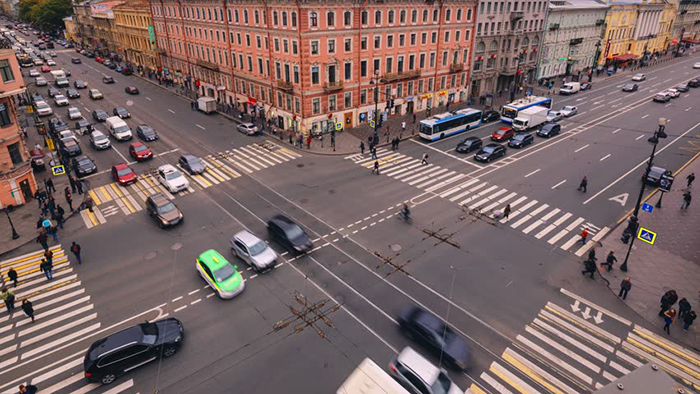
In most Moscow traffic lights, a section with a turn arrow lights up green or right when turning is allowed and goes out when turning is not allowed. In the section of the main green signal of such a traffic light is drawn a thin black outline of the arrow direction of motion. This black circuit also informs the driver about the presence of an additional traffic light section. This interface has flaws. The black contour arrow at night (and in other conditions of poor visibility) can be overlooked. An additional section of the traffic light, when the arrow is off, is also not visible. And if it is visible - it is not clear, the arrow is working and you just need to wait, or the section is broken. As a result, drivers often turn without waiting for the green arrow. This increases the number of accidents at the intersection.
Decision. The arrows of the side sections of the traffic light should be constantly visible and be lit either in green (when turning is allowed), or red (when turning is not allowed), or flashing yellow. This is a simple and intuitive option tested in practice in the USA (see figure below).
')
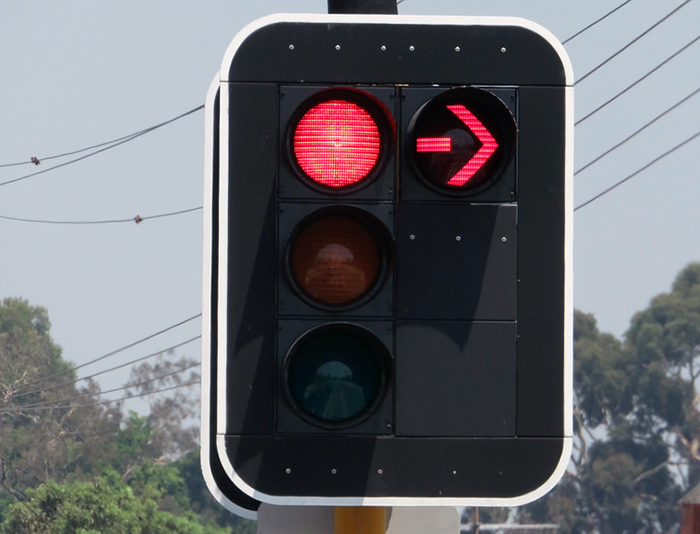
In Moscow, the problem began to be solved a couple of years ago, installing such traffic lights:
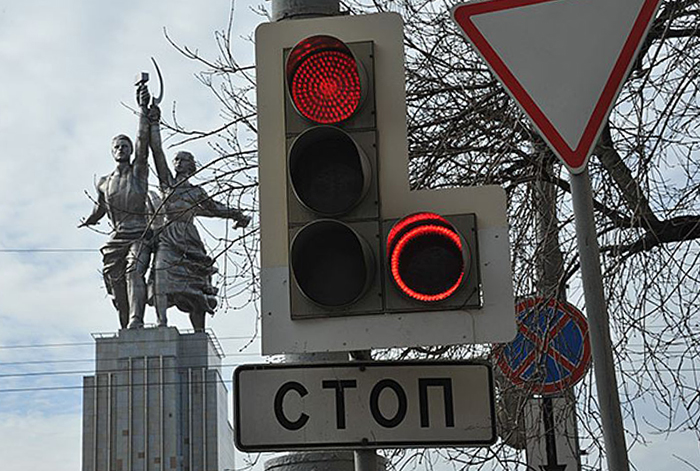
When turning is enabled, the green arrow in the additional section is lit. When disabled, the red circle is lit in the extra section. This option is better than when only the green arrow is on, but intuitively inferior to the burning red arrow, with no other advantages. An intuitive interface is a must for systems where the price of a user error can cost people’s life, health and property. Traffic lights and pedestrian crossings belong to such systems.
Ambiguity arises at crossings, where there are at least two, and sometimes more, options for movement from the point where the pedestrian stands. As a rule, these options are not available at the same time. And often the sound signal does not make it clear in which direction the crossing of the road is permitted. For example, a classic cross-road intersection of two roads. The sound signal is distributed from two traffic lights, in the figure below marked with the letters B and D.
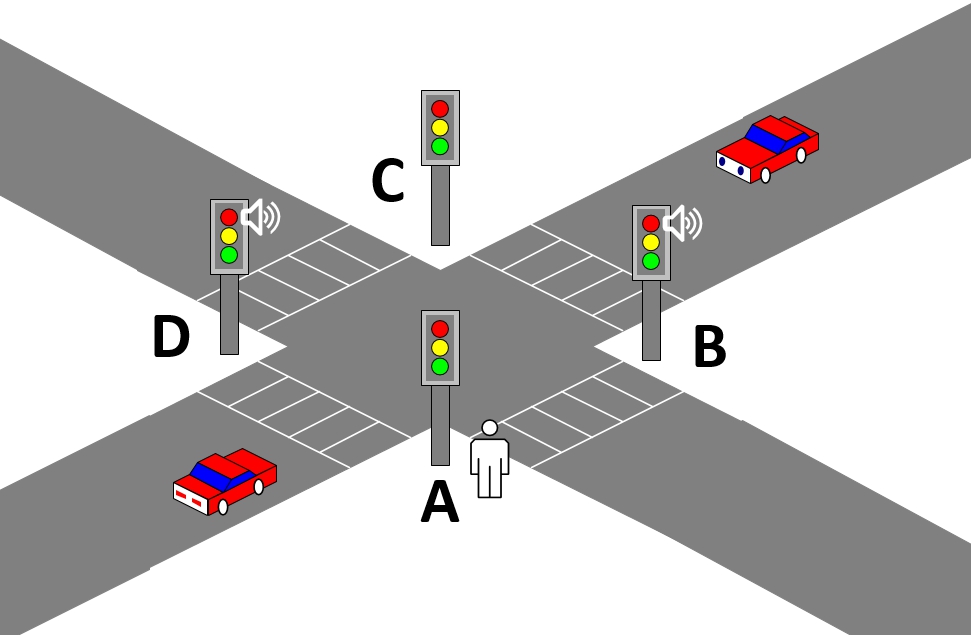
A blind pedestrian wants to cross the road in the direction of AB. Under his feet lies a special relief tile. Being on the tile, the pedestrian realizes that he has chosen the right direction and is facing the traffic light B. Therefore, he will not respond correctly to the sound signal of traffic light D, which will be clearly heard to the left of the pedestrian. But traffic light B emits the same sound signal in the case of green light on segment AB, and in the case of green light on segment BC. These segments are available in turn for the transition, therefore, while the pedestrian is green for the segment BC, the segment AB is red and vehicles are moving. Passing the segment AB, while the green light is on for the segment BC, the pedestrian cannot, but focusing only on the sound signal of the traffic light, he will not understand this at all.
Decision. Installing audio signals at each of the intersection traffic lights in the above example will not solve the problem, but it will improve the situation. It will be possible to compare the two signals of the near and far traffic lights by ear and determine the direction of the transition. The method will not work if sounding at the same time there will be more than two traffic lights. Another option is to install sound devices above the transition, in the form of a string of lights stretched along the length of the transition. The garland will form a sound line corresponding to the trajectory of movement along the transition. In this case, by ear, the pedestrian will understand whether he is moving along the line of movement or has begun to move away from it.
I think that every pedestrian at least once and came across an inconspicuous duration of a green pedestrian traffic light signal. Then on a multi-lane highway give 10-15 seconds, which are not enough for a quick walk to a healthy adult (for example, at the intersection of Kalanchevskaya street and Academician Sakharov Avenue in Moscow). Then a three-meter-wide lane will take a minute. Why?
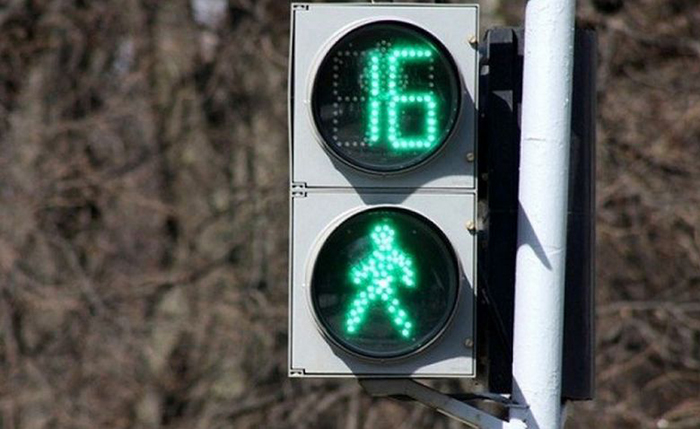
The transition time through the roadway depends on each particular section. According to the data center of Moscow, the duration of the green signal is calculated using the formula T = S / V + 3-5 seconds (the burning time of the green signal is equal to the width of the carriageway divided by the average speed at a step (5 km / h) + 3-5 seconds for ensure the transition of the road to the elderly and people with limited mobility). But this formula is advisory in nature, as well as the waiting time of the green light, which should not be more than two minutes, because it is psychologically difficult for pedestrians to wait a long time for the permissive signal to go.
Also, the duration of the signal is influenced by the type of controller installed at a specific traffic light and the intensity of traffic on this section of the road. Old lamp controllers cannot be flexibly adjusted depending on the current traffic situation, new computer ones are possible. The factors listed above lead to such a difference in the duration of the traffic signal.
Decision. The duration of the green signal for pedestrians must be balanced. We should not allow frequent and long pedestrian phases of traffic lights to create traffic jams, we should not set waiting times for pedestrians for too long, thus provoking them to switch to red light. Improving the situation is a joint task of the residents of the city and the responsible municipal departments. The task of the residents is to inform the authorities about situations when there is not enough time to go or if the waiting time is too long. You can leave a request in Moscow on the United Transport Portal . The authorities should modernize the traffic light fleet, install new equipment that can adapt the transition time to the current traffic situation. Installing the call panels solves the problem on the streets in residential areas where there is no heavy pedestrian traffic. In the central and commercial areas, redesigning the streets, narrowing the width of the lanes and reducing their number will help, thereby reducing the time needed for pedestrians to cross the road.
Common situation A pedestrian waits patiently for the 140 seconds indicated on the timer to expire. Five seconds left, four, three, two - the pedestrian impatiently starts moving along the crossing, but in vain, because the traffic light timer does not match the signal and the red color will light up for another 20 seconds after the countdown. This is a serious and dangerous drawback when setting up a traffic light, which simply should not be.
Decision. Road services and TsODD should carefully check the synchronization of the work of elements of the traffic light. The main responsibility is preferably assigned to the equipment manufacturers. It is necessary at the software and hardware level to exclude the possibility of desynchronization of the timer, the scoreboard and the traffic light controller. In order to involve local residents in monitoring the work of traffic lights, it makes sense for the city authorities to create a mobile application with the help of which residents can send complaints about traffic lights. In Moscow, this application is made, it is called Our City .

Pedestrians need to be more attentive and cross the road only to the green signal of the traffic light, and not at the last seconds of the countdown timer (which, by the way, is a traffic violation), as well as fix the traffic light problems found and send them through Our city.
Some people, seeing a yellow signal or a countdown of the last seconds of the green signal on a traffic light timer, begin not to slow down, but, on the contrary, to accelerate. This is a sin for both motorists and pedestrians who do not want to wait 2-3 minutes to cross the three-meter street. In another situation, people see that less than five seconds are left until the green signal and begin to move to a red light, without waiting for the green signal.
Timers at traffic lights are suggested to be abandoned - either entirely , or partially, only from the red timer . Disagree with both options. The countdown timer helps both drivers and pedestrians to evaluate the remaining time and figure out whether to take these or other actions. The driver, seeing that he still has 120 seconds before the end of the red signal, can safely get out of the car and wipe the windshield, make a phone call or finish eating a burger. A pedestrian will notice that 10 seconds are left of the green signal, realize that he does not have time, and will not be in a hurry. The benefit of the countdown timer is.
The reason for the countdown violations is not in the timers, but in the psychology of the people. We do not like to wait and try not to wait if the refusal of waiting does not cause us any noticeable losses (both economic, moral and physical). If a person needs to see a doctor, he will wait for the doctor, because the result of not giving up waiting will be physical suffering. But if there is a chance to avoid the queue or bypass it - people will take advantage of this with pleasure.

People stand in line for scarce goods, not because they like to stand in line, but because the result of refusal to wait in line is a person’s lack of this scarce product. People are accelerating at the last seconds of the traffic signal because, a) they don’t want to wait, in principle, and b) they think that the refusal of waiting (acceleration to yellow, completion of movement to red) will not lead to any losses. With the point A you can not do anything, but the expectations of people from point B can be controlled.
Decision. We divide the situation into two types. The first is when people start moving on a red light, 3-5 seconds before turning on the green signal. The second is when they are accelerating to green light, seeing that less than 10 seconds of the green signal time is left. Another way to divide situations is by the type of intruder (motorist or pedestrian). As a result, we get four types of situations, in each of which there will be different ways to solve the problem.
Situation 1.1. A motorist is driving a red light. The position of the law is clear, paragraph 6.2 of the traffic rules prohibits movement to a red light. Article 12.12 of the Administrative Code establishes for the first violation a fine of 1000 rubles, for repeated (during the year) - 5000 rubles or deprivation of rights for 4-6 months. A fine is the loss of a motorist if you give up waiting. The significance of such a loss consists of two factors — the probability of obtaining a fine and its size. Increasing one or both multipliers, we increase the significance of the loss for the violator, we reduce the number of violations.
The likelihood of a fine depends on the system for monitoring compliance with traffic rules. If at the intersection there are no means of fixing violations, then the probability of getting a fine, according to the driver, tends to zero. Therefore, regardless of the value of the fine (the second multiplier), the total loss of a motorist in case of failure to wait will be zero. Increase the likelihood of getting a fine by improving control systems and increasing their number. To save budgetary funds, you can use not models, but dummies on some sections of the road. They are several times cheaper, but also have a restraining effect, as well as full-fledged cameras (provided that drivers do not know whether it is a fake or a camera). I recommend to keep the number of models in the ratio of not more than 20 percent of the number of cameras, otherwise the restraining effect will change to the opposite.
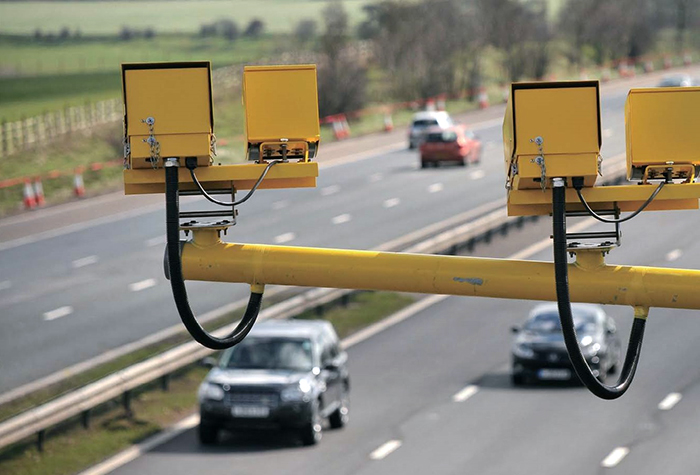
The primary fine of one thousand rubles for many motorists is the allowable loss. Especially in large cities and for people with incomes above average. The size of the fine for traveling on red light needs to be increased. This is not a regional task, but a federal one, since changes are made to the Administrative Code. The principle of the formation of a fine, too, needs to be revised. Increase the minimum level of the fine by at least ten times (up to ten thousand rubles for the primary violation) and make a flexible premium depending on the level of income of the offender. The method of calculating such fines is a topic for a separate article. But the combination of a tangible minimum fine (which is paid in any case) and an allowance from the income level will make it possible for anyone not to feel impunity. Drivers of middle income with a white salary, drivers with a gray salary and drivers with a high level of income will be in equal conditions.
Progressive fines are successfully applied in many European countries and the number of deaths in road accidents in such countries is several times less than in Russia. Also, when reforming fines for violating traffic rules, you should pay attention to the Russian experience in the field of weapons legislation. There, the laws are much more stringent, but they do not cause any mass discontent with the owners of weapons, and the number of violations of the law on weapons is several times less than violations of traffic rules. Largely due to the severity of the law, which provides for the possible free of charge confiscation of weapons for a single serious violation of the law. Now imagine that for exceeding the speed of 40+ kilometers, a car is taken from the driver. Mass indignation of unscrupulous motorists is guaranteed, but after a couple of years of this practice, the situation on the roads will change for the better.
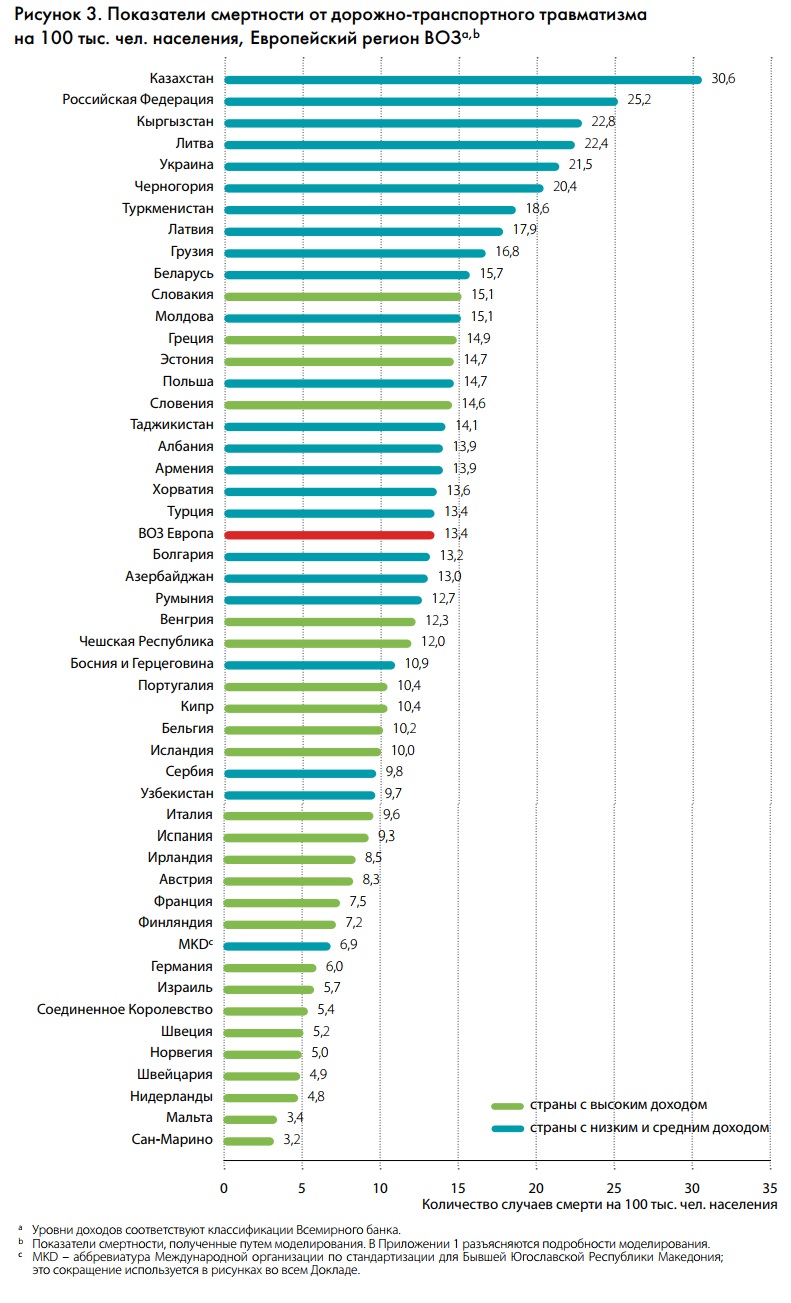
Mortality statistics in traffic accidents according to the World Health Organization's Regional Office for Europe
Situation 1.2. A motorist drives a yellow light or accelerates in the last seconds of green. The situation, from the point of view of the law, is ambiguous. The flashing green light, like the last seconds of the countdown timer, does not impose any restrictions on the driver’s movement. A yellow signal can be driven (Section 6.14 of Traffic Regulations), if one could only stop in front of a traffic light by emergency braking. The scheme is simple - legally overclocked in the last seconds of the green signal, the yellow signal does not reset the gained speed without emergency braking - everything is legal. The letter of the law is respected, the spirit is not very.
But with the help of the letter of the law, this situation can be improved. According to p. 6.2 of traffic rules, movement on yellow light, as well as on red, is prohibited. Therefore, it is possible to fine drivers driving on the yellow light in the same automatic mode using video violation recording cameras. Leaving the possibility to further dispute this penalty, for example, by providing an entry from the registrar. Those drivers who could not stop without emergency braking will be avoided. Most of the rest will prefer not to risk and slow down for a smooth stop at the yellow traffic signal.
I recall that the beloved by many reference to the presumption of innocence does not work here. The presumption of innocence extends to criminal rather than administrative proceedings. Therefore, the approach “first write out a fine, and then prove that it is not a camel” in the situation described above is legal.
Situations 2.1 and 2.2. In both situations pedestrians are also violators, but the whip method does not work with them. A pedestrian does not drive a vehicle of increased danger, therefore, the requirements for him are lower. A pedestrian does not pass a medical examination to obtain the right to walk on the roads, does not pass exams on the theory of traffic rules. A pedestrian is not required to carry an identity document with him; he may be a minor, drunk or incapacitated. Influencing pedestrians need propaganda and gingerbread.
With the help of propaganda we form people’s conviction that it is fashionable, stylish and youthful to comply with traffic rules. There are plenty of methods for such propaganda; I’m not going to talk about them in the article. As for the gingerbread, then the task is complicated because of the impossibility of automatic identification of pedestrians. In theory, gamification should work: to encourage a pedestrian for not having broken a rule for a month, switching to a green light a hundred times, etc. In practice, this will not work without installing automatic face recognition on every transition of a camera connected to a neural network. In Moscow, such a system is only being tested in industrial operation in the metro. After how many years each transition will be connected to this system (or at least 20-30% of transitions) - I do not undertake to predict. And the economic feasibility of such a decision raises questions.
Another way to improve the situation with the observance of traffic rules by pedestrians is to launch voluntary traffic police courses for pedestrians, with encouragement in case of passing the final exam. Commemorative badges, extra points in an Active Citizen - something tangible and pleasant. Literate, traffic-friendly pedestrians are beneficial to the state - they are less likely to fall into an accident, so the state spends less money on their treatment and receives more income from able-bodied and healthy citizens. Encouraging pedestrians and drivers who observe traffic rules is part of a more general theme of encouraging citizens to conduct correct (in the context of state interests) behavior of citizens. The topic deserves separate research and articles.
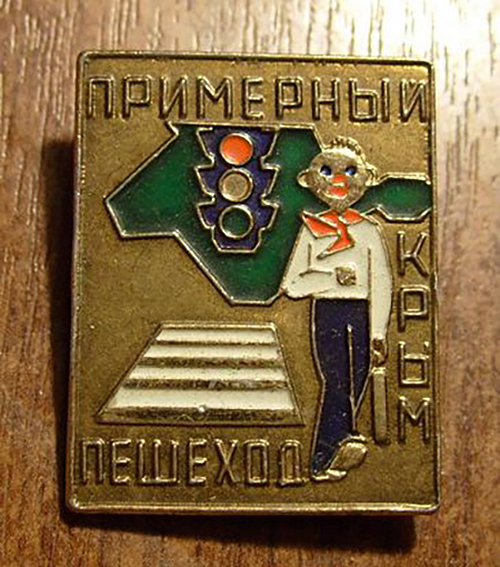
Soviet example of using game mechanics to encourage pedestrians
This is the fault of some traffic lights with a button (calling board), which the pedestrian presses to turn on the green light for him. The worst case is when, after pressing, the button does not light up in any way, it does not go into the pressed state. The pedestrian does not see the reaction of the traffic light to the action and assumes that the traffic light is broken, after which he crosses the road to a red light. I have not seen the model of the calling board, in which the reaction to pressing the button is not provided - most often the backlight lamp is simply broken in them.
There is a case when the traffic light is equipped with a button for pedestrians and a countdown timer of the traffic light. In some models of traffic lights, in dormant situations, dashes are shown instead of counting the remaining time. Pressing the button of such a traffic light, the pedestrian intuitively waits for the next confirmation of the action - the button will light up, go into the pressed state, and the countdown will immediately begin on the timer until the red signal for the pedestrian changes to green. And the reaction of the timer is priority here - if the button does not light up, but the countdown has gone, the understanding that the system is working appears. If on the contrary - the button lights up, but nothing has changed on the timer - people think that the system is not working and they turn on a red light.
I repeatedly saw a situation when at such a traffic light the button came on, but the timer reacted 10-12 seconds after pressing the button:
I conducted an experiment in which I observed the behavior of pedestrians in this situation. Of the fifty pedestrians, thirty-eight (76% of the total) did not wait for the countdown timer to start and decided to cross the road to a red light. The average response time from the traffic light was 5.6 seconds. The remaining twelve pedestrians were waiting for the start of the timer and the green signal of the traffic light. I have no data on whether these people knew about the features of the timer on this transition or were simply patient.
Decision. The button should respond to user action, a bunch of "button + timer" too. If in such a bundle the timer does not react or reacts with a delay, then this bundle is perceived by pedestrians as not functioning. At first glance, the solution looks obvious and simple, but it cannot be implemented until the city makes uniform technical requirements for all elements of the traffic light system. Without such requirements, when synchronizing the work of equipment from different manufacturers, difficulties arise - from bugs to impossibility of synchronization.
What should be a good button to turn on a green signal for a pedestrian traffic light, or, speaking in an official language, the pedestrian calling board? It is located next to the traffic light, unambiguously making it clear by the location, to which traffic light it belongs. She does not force the user to think, her behavior is perceived unequivocally. The button is easily visible from afar, not traumatic, convenient to use, adapted for hearing impaired and visually impaired pedestrians, resistant to temperature extremes, precipitation and vandalism. At the same time, the design of the button does not spoil the appearance of the city and harmonizes with the surrounding area.
Those buttons that I met on Russian roads do not meet the criteria described above. I will give examples:
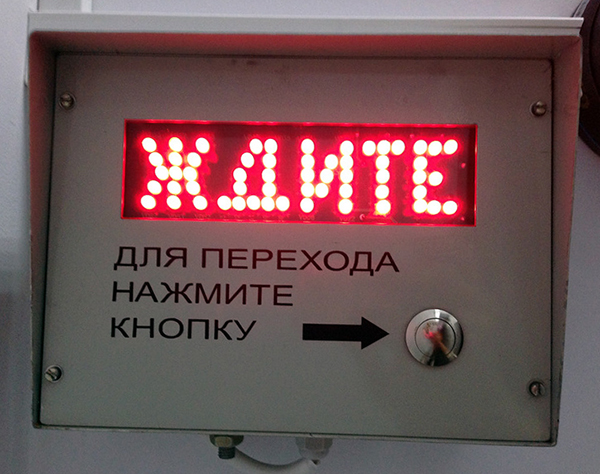
This option is poorly visible from the side (the body merges with the color of the pillar and the surrounding gray weather), traumatic (if a cyclist or a pedestrian stumbles across a sharp corner of the body) and frankly terrible in terms of urban design. I am silent about adaptation for pedestrians with hearing and sight problems - I have not seen it anywhere.
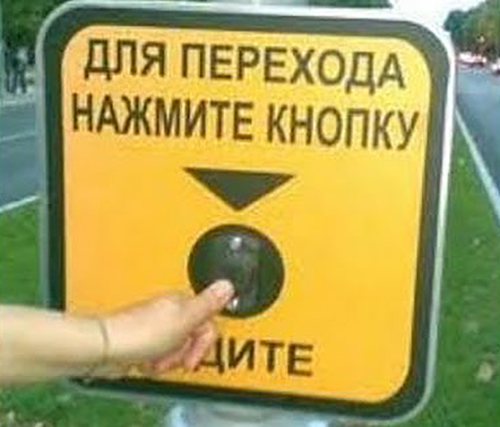
This scoreboard is visible only on the one hand, uninformative and unreasonably large.
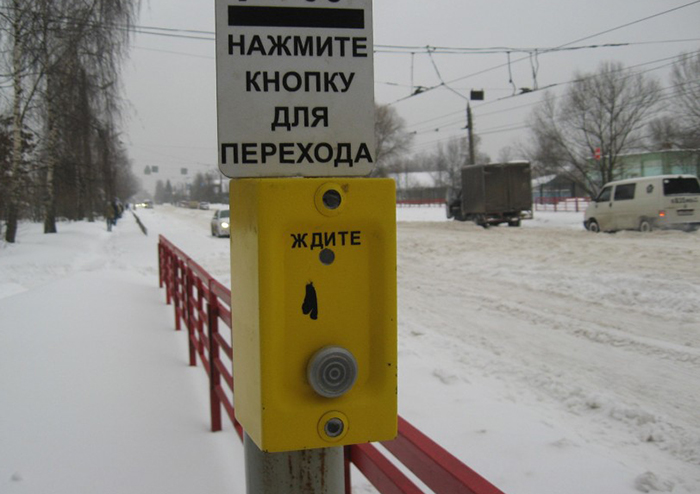
Common option in Moscow. More successful than the previous two, but has a number of drawbacks - acute corners of the body, lack of information, lack of adaptation for the visually impaired and blind people.
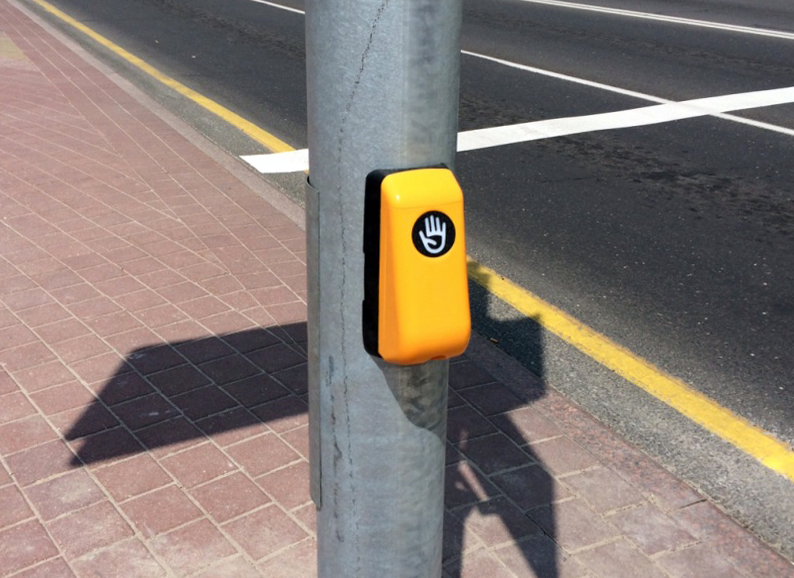
A variant with a touch panel, distributed in Moscow. Uninformative, the button illumination is poorly visible in daylight, faintly visible from other sides. The touch button in the winter makes remove gloves. But I note a nice design and rounded corners, less traumatic than sharp.
Let's see how things stand in other countries with the traffic light buttons. It turns out, not better than in Russia.
Here is a beautiful specimen from Ukraine in its concise postapocalypticity (see the link).

In the countries of East Asia, buttons similar to the Russian versions are used. But here an electronic display was added, making the display informative.

Again, a touch of traffic lights, this time from Eastern Europe. As you can see, the paint was used short-lived - it is unlikely that the scoreboard is more than a few years old, and the inscriptions and the button are almost invisible.

Hardcore and brutal, as a good old school porn, the German version. With all the flaws, he still causes sympathy.
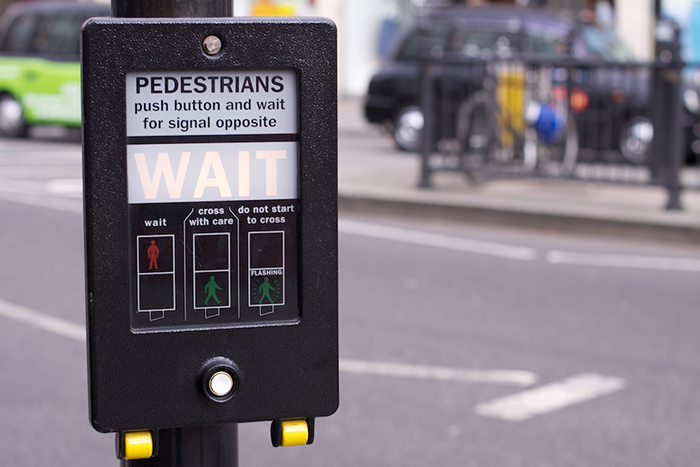
The scoreboard merges with the pillar, overloaded with text and pictograms. This is not what you expect from London - sort of like Mecca of modern design.
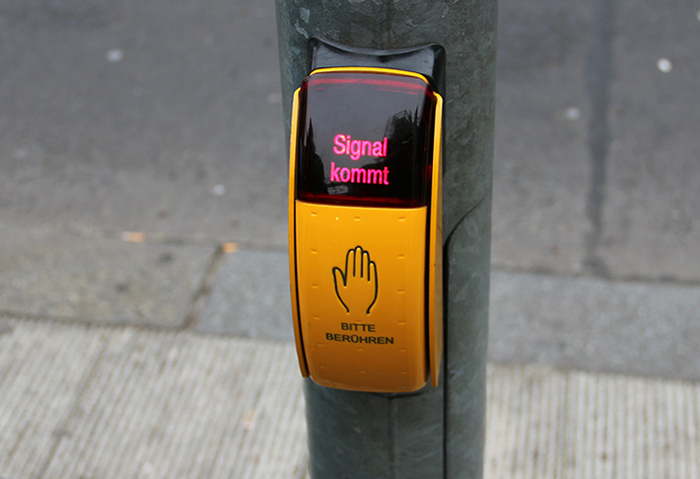
The cutest of the foreign options I found. The design is good, the LCD panel is bright and contrast, the touch button is embossed and informative.
The above call panels do not fully meet the requirements formulated in the article. I tried to present a board in which these requirements are taken into account. It turned out this:

The body of the scoreboard is bright orange with rounded corners. The case fastening (of the same color) encircles the pole, making the scoreboard visible from either side. On the case, on the front part there is a round, protruding three to five millimeters from the case, a mechanical button. Unlike the touch one, you do not need to take off your gloves in the cold to press it; such a button is easier to find for blind people by touch. The button should not be pressed tightly. It is important that the button has a large margin of safety (resistance to vandals and weather conditions). The button on the circle is illuminated by bright LEDs. Pending button backlight is bright white. It draws attention to the button, bright white diodes are noticeable at any time of the day, work for several years, consume little energy. After pressing the button, the backlight changes to yellow. As soon as you can go,the backlight color changes to green.
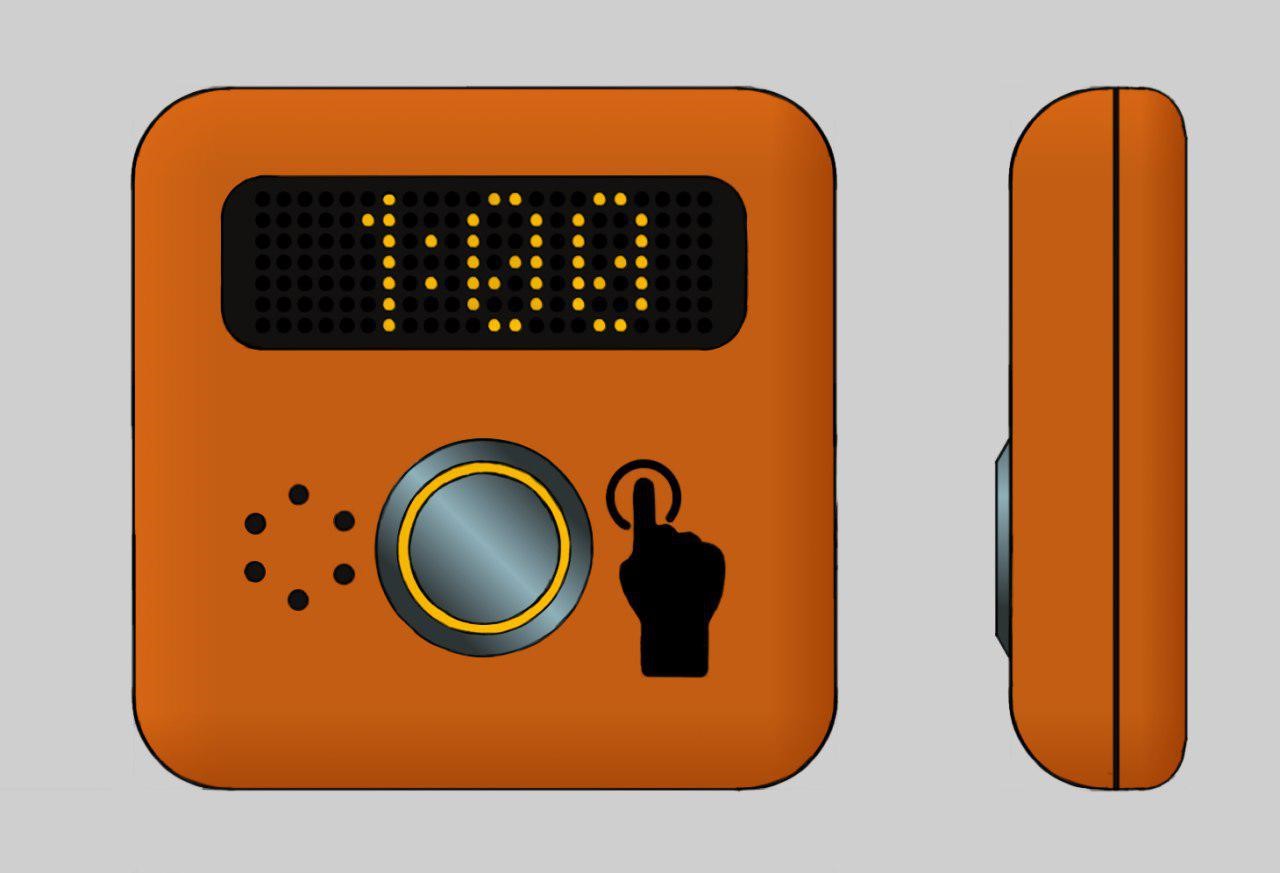
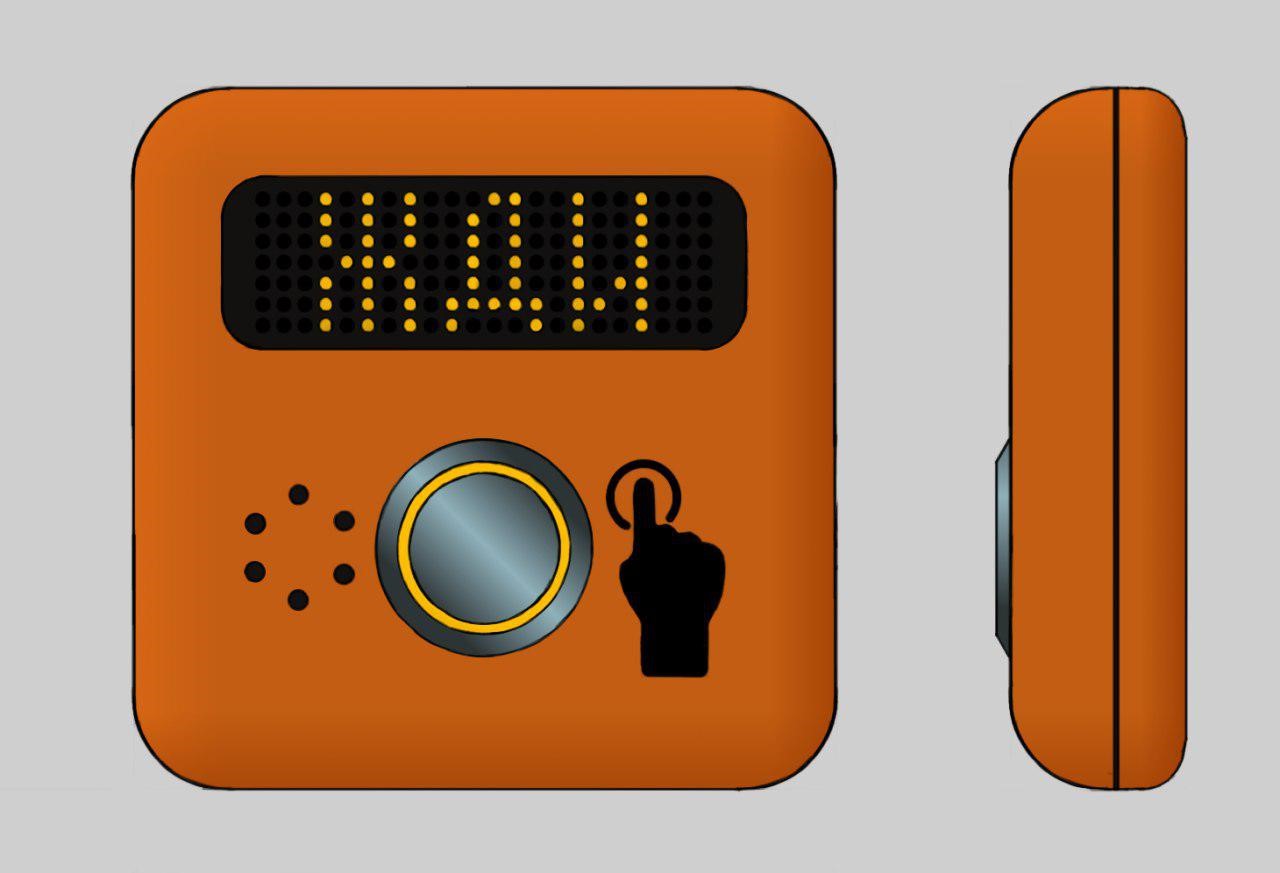
To the left of the button is a speaker, which emits sounds when the button is pressed and changes the tone of sounds when the traffic light turns green. It will help to orient when passing to blind pedestrians and gives a response from the display interface to user actions (pressing a button).
To the right of the button is an intuitive pictogram explaining the functions of the scoreboard for pedestrians who do not speak Russian and English.
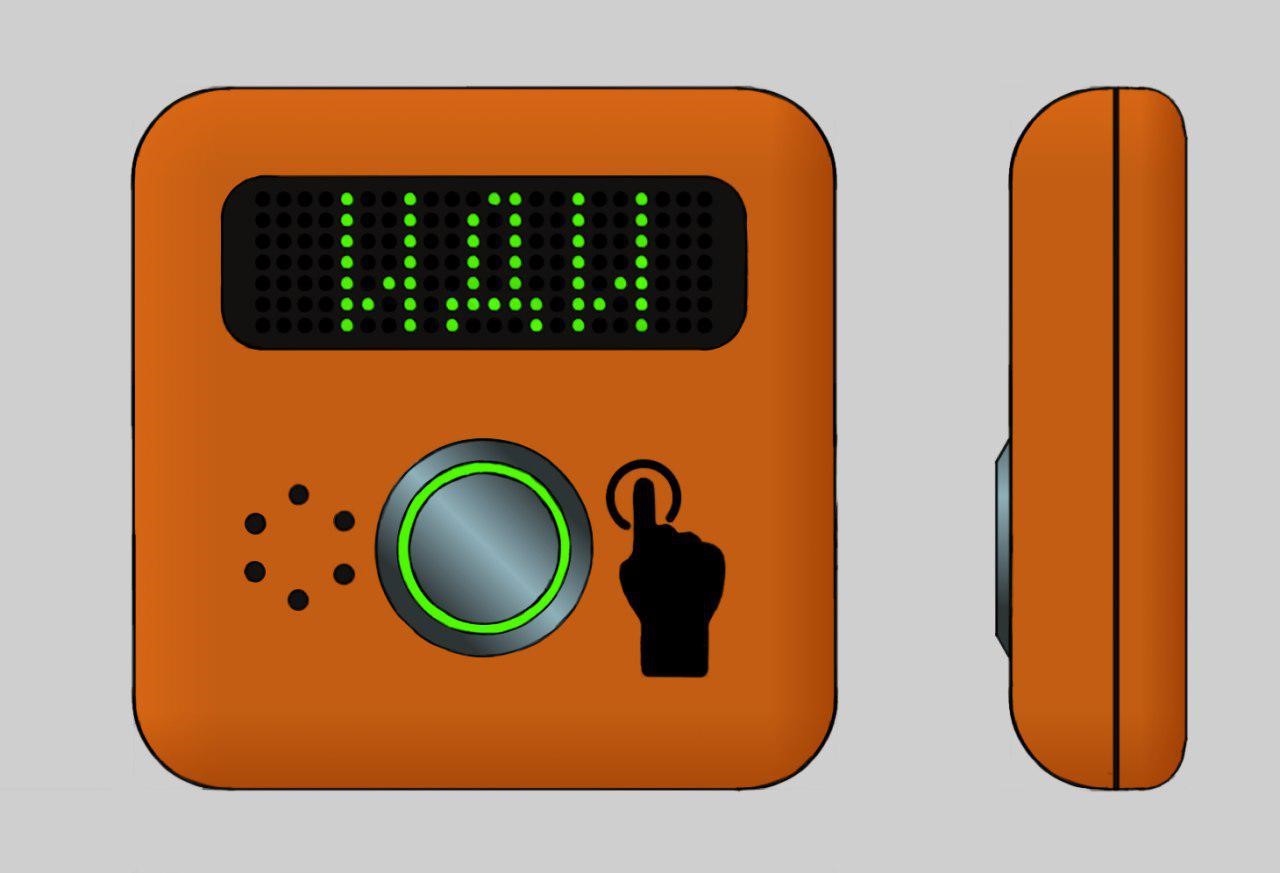
Above the button is a LED display. In the standby mode, the word “PUSH” is displayed in white, alternating with the English word “PUSH” at intervals of several seconds. The English version has been added to increase the tourist attractiveness of Russian cities for foreign citizens. Also, the periodic blinking of the text draws additional attention of pedestrians to the scoreboard. After pressing the button with the pedestrian, the text color changes to yellow, and the text itself - to WAIT (WAIT). At the same time, in addition to the alternation of Russian and English texts, the countdown counter is displayed in minutes and seconds before the green light signal is turned on. After turning on the green signal of the traffic light, the text color changes to green, the inscriptions change to IDN (GO),and the timer counts down the time in minutes and seconds until the green light ends.

The scoreboard is placed on the pole nearest to the transition - in order to uniquely identify oneself as relating to this transition. The board is installed at a height of one meter. The button will be comfortable to press for people of medium and high growth, children and wheelchair users. In the traffic lights, you need to adjust the minimum delay after the pedestrian cycle (so as not to paralyze traffic by several taps in a row). If this delay has passed, the traffic light switches to green immediately after pressing the button. Thus, we avoid situations where the last time the button was pressed half an hour ago, and it makes the pedestrian wait two or three automobile cycles for a total duration of 120 seconds.

After analyzing possible solutions to the identified problems, a short list of actions of municipal and federal authorities was formed. Full or partial implementation of the following actions will improve safety at pedestrian crossings and reduce the number of accidents in the city.
Uniform municipal requirements
The city needs to develop and approve a single set of technical and visual requirements for the elements of the system of pedestrian crossings (traffic lights, call panels, facilities for the disabled, tactile tiles, etc.) These requirements will solve scoreboard and traffic lights to a single style and interface.
Civil control
It is impossible to develop and maintain a comfortable and safe city without the active participation of urban residents. Technical means for such control have been created in Moscow (for example, the “Our City” portal), but there is not enough propaganda of civic responsibility (for a part of the population, civic responsibility is associated with something negative: “squealing” and other prison terms). Both the technical means and the propaganda of the lifestyle of a citizen who is not indifferent to his city should be further developed by the forces of the municipal authorities.
"Gingerbread" for the beneficial actions of citizens
Municipal authorities should encourage citizens to be active in affairs that are good for the city and control the behavior of citizens, encouraging them to be so active. To do this, it is necessary, among other things, to improve the system of city awards, using modern game mechanics. Awards and honorary titles of Moscow look out of reach for citizens. The principles and conditions for obtaining them are vague and incomprehensible, so the rewards do not provide the necessary motivational effect. Gamification provides us with extensive opportunities for the modification of the reward system that existed during the USSR times; this is an extensive topic that goes beyond the article and deserves a separate article.
Integration with Active Citizen
To encourage pedestrians and drivers, an online platform is needed on which incentives, rewards, tests, and reference information will be collected. In Moscow, such a platform has been created, it is “Active Citizen”. Its modification and development will come out cheaper than creating a new platform. It is more convenient for users to use one application or site instead of several.
Fines change
Difficult and ambiguous conclusion. It is obvious that the size of the fines does not have the desired effect on most drivers, and the system of fines needs to be processed. This is a federal task that requires discussion by expert groups. It is necessary to increase the penalties for serious violations of traffic rules (violations that are likely to lead to injuries and victims among the participants of the accident). The mechanism for generating the final amount of the fine must be flexible and consist of a base amount and a premium depending on the income level of the offender. Such a mechanism will make it possible to achieve equal (in the context of social justice) responsibility for traffic violations for all participants in the movement.
In the end, I would like to thank Ivan Chernyshev (aka Mokou Fujiwarrior) for creating illustrations for the article, Pavel Kotosov (teddyfood.com) and Irina Melikhova for reading and helpful tips for improving the article.

Problems
Cannot see the turn arrow
In most Moscow traffic lights, a section with a turn arrow lights up green or right when turning is allowed and goes out when turning is not allowed. In the section of the main green signal of such a traffic light is drawn a thin black outline of the arrow direction of motion. This black circuit also informs the driver about the presence of an additional traffic light section. This interface has flaws. The black contour arrow at night (and in other conditions of poor visibility) can be overlooked. An additional section of the traffic light, when the arrow is off, is also not visible. And if it is visible - it is not clear, the arrow is working and you just need to wait, or the section is broken. As a result, drivers often turn without waiting for the green arrow. This increases the number of accidents at the intersection.
Decision. The arrows of the side sections of the traffic light should be constantly visible and be lit either in green (when turning is allowed), or red (when turning is not allowed), or flashing yellow. This is a simple and intuitive option tested in practice in the USA (see figure below).
')

In Moscow, the problem began to be solved a couple of years ago, installing such traffic lights:

When turning is enabled, the green arrow in the additional section is lit. When disabled, the red circle is lit in the extra section. This option is better than when only the green arrow is on, but intuitively inferior to the burning red arrow, with no other advantages. An intuitive interface is a must for systems where the price of a user error can cost people’s life, health and property. Traffic lights and pedestrian crossings belong to such systems.
Incomprehensible beeps
Ambiguity arises at crossings, where there are at least two, and sometimes more, options for movement from the point where the pedestrian stands. As a rule, these options are not available at the same time. And often the sound signal does not make it clear in which direction the crossing of the road is permitted. For example, a classic cross-road intersection of two roads. The sound signal is distributed from two traffic lights, in the figure below marked with the letters B and D.

A blind pedestrian wants to cross the road in the direction of AB. Under his feet lies a special relief tile. Being on the tile, the pedestrian realizes that he has chosen the right direction and is facing the traffic light B. Therefore, he will not respond correctly to the sound signal of traffic light D, which will be clearly heard to the left of the pedestrian. But traffic light B emits the same sound signal in the case of green light on segment AB, and in the case of green light on segment BC. These segments are available in turn for the transition, therefore, while the pedestrian is green for the segment BC, the segment AB is red and vehicles are moving. Passing the segment AB, while the green light is on for the segment BC, the pedestrian cannot, but focusing only on the sound signal of the traffic light, he will not understand this at all.
Decision. Installing audio signals at each of the intersection traffic lights in the above example will not solve the problem, but it will improve the situation. It will be possible to compare the two signals of the near and far traffic lights by ear and determine the direction of the transition. The method will not work if sounding at the same time there will be more than two traffic lights. Another option is to install sound devices above the transition, in the form of a string of lights stretched along the length of the transition. The garland will form a sound line corresponding to the trajectory of movement along the transition. In this case, by ear, the pedestrian will understand whether he is moving along the line of movement or has begun to move away from it.
Too small or too long road crossing time
I think that every pedestrian at least once and came across an inconspicuous duration of a green pedestrian traffic light signal. Then on a multi-lane highway give 10-15 seconds, which are not enough for a quick walk to a healthy adult (for example, at the intersection of Kalanchevskaya street and Academician Sakharov Avenue in Moscow). Then a three-meter-wide lane will take a minute. Why?

The transition time through the roadway depends on each particular section. According to the data center of Moscow, the duration of the green signal is calculated using the formula T = S / V + 3-5 seconds (the burning time of the green signal is equal to the width of the carriageway divided by the average speed at a step (5 km / h) + 3-5 seconds for ensure the transition of the road to the elderly and people with limited mobility). But this formula is advisory in nature, as well as the waiting time of the green light, which should not be more than two minutes, because it is psychologically difficult for pedestrians to wait a long time for the permissive signal to go.
Also, the duration of the signal is influenced by the type of controller installed at a specific traffic light and the intensity of traffic on this section of the road. Old lamp controllers cannot be flexibly adjusted depending on the current traffic situation, new computer ones are possible. The factors listed above lead to such a difference in the duration of the traffic signal.
Decision. The duration of the green signal for pedestrians must be balanced. We should not allow frequent and long pedestrian phases of traffic lights to create traffic jams, we should not set waiting times for pedestrians for too long, thus provoking them to switch to red light. Improving the situation is a joint task of the residents of the city and the responsible municipal departments. The task of the residents is to inform the authorities about situations when there is not enough time to go or if the waiting time is too long. You can leave a request in Moscow on the United Transport Portal . The authorities should modernize the traffic light fleet, install new equipment that can adapt the transition time to the current traffic situation. Installing the call panels solves the problem on the streets in residential areas where there is no heavy pedestrian traffic. In the central and commercial areas, redesigning the streets, narrowing the width of the lanes and reducing their number will help, thereby reducing the time needed for pedestrians to cross the road.
The countdown is over - and the green did not light up
Common situation A pedestrian waits patiently for the 140 seconds indicated on the timer to expire. Five seconds left, four, three, two - the pedestrian impatiently starts moving along the crossing, but in vain, because the traffic light timer does not match the signal and the red color will light up for another 20 seconds after the countdown. This is a serious and dangerous drawback when setting up a traffic light, which simply should not be.
Decision. Road services and TsODD should carefully check the synchronization of the work of elements of the traffic light. The main responsibility is preferably assigned to the equipment manufacturers. It is necessary at the software and hardware level to exclude the possibility of desynchronization of the timer, the scoreboard and the traffic light controller. In order to involve local residents in monitoring the work of traffic lights, it makes sense for the city authorities to create a mobile application with the help of which residents can send complaints about traffic lights. In Moscow, this application is made, it is called Our City .

Pedestrians need to be more attentive and cross the road only to the green signal of the traffic light, and not at the last seconds of the countdown timer (which, by the way, is a traffic violation), as well as fix the traffic light problems found and send them through Our city.
The countdown of the traffic light provokes people to violations
Some people, seeing a yellow signal or a countdown of the last seconds of the green signal on a traffic light timer, begin not to slow down, but, on the contrary, to accelerate. This is a sin for both motorists and pedestrians who do not want to wait 2-3 minutes to cross the three-meter street. In another situation, people see that less than five seconds are left until the green signal and begin to move to a red light, without waiting for the green signal.
Timers at traffic lights are suggested to be abandoned - either entirely , or partially, only from the red timer . Disagree with both options. The countdown timer helps both drivers and pedestrians to evaluate the remaining time and figure out whether to take these or other actions. The driver, seeing that he still has 120 seconds before the end of the red signal, can safely get out of the car and wipe the windshield, make a phone call or finish eating a burger. A pedestrian will notice that 10 seconds are left of the green signal, realize that he does not have time, and will not be in a hurry. The benefit of the countdown timer is.
The reason for the countdown violations is not in the timers, but in the psychology of the people. We do not like to wait and try not to wait if the refusal of waiting does not cause us any noticeable losses (both economic, moral and physical). If a person needs to see a doctor, he will wait for the doctor, because the result of not giving up waiting will be physical suffering. But if there is a chance to avoid the queue or bypass it - people will take advantage of this with pleasure.

People stand in line for scarce goods, not because they like to stand in line, but because the result of refusal to wait in line is a person’s lack of this scarce product. People are accelerating at the last seconds of the traffic signal because, a) they don’t want to wait, in principle, and b) they think that the refusal of waiting (acceleration to yellow, completion of movement to red) will not lead to any losses. With the point A you can not do anything, but the expectations of people from point B can be controlled.
Decision. We divide the situation into two types. The first is when people start moving on a red light, 3-5 seconds before turning on the green signal. The second is when they are accelerating to green light, seeing that less than 10 seconds of the green signal time is left. Another way to divide situations is by the type of intruder (motorist or pedestrian). As a result, we get four types of situations, in each of which there will be different ways to solve the problem.
Situation 1.1. A motorist is driving a red light. The position of the law is clear, paragraph 6.2 of the traffic rules prohibits movement to a red light. Article 12.12 of the Administrative Code establishes for the first violation a fine of 1000 rubles, for repeated (during the year) - 5000 rubles or deprivation of rights for 4-6 months. A fine is the loss of a motorist if you give up waiting. The significance of such a loss consists of two factors — the probability of obtaining a fine and its size. Increasing one or both multipliers, we increase the significance of the loss for the violator, we reduce the number of violations.
The likelihood of a fine depends on the system for monitoring compliance with traffic rules. If at the intersection there are no means of fixing violations, then the probability of getting a fine, according to the driver, tends to zero. Therefore, regardless of the value of the fine (the second multiplier), the total loss of a motorist in case of failure to wait will be zero. Increase the likelihood of getting a fine by improving control systems and increasing their number. To save budgetary funds, you can use not models, but dummies on some sections of the road. They are several times cheaper, but also have a restraining effect, as well as full-fledged cameras (provided that drivers do not know whether it is a fake or a camera). I recommend to keep the number of models in the ratio of not more than 20 percent of the number of cameras, otherwise the restraining effect will change to the opposite.

The primary fine of one thousand rubles for many motorists is the allowable loss. Especially in large cities and for people with incomes above average. The size of the fine for traveling on red light needs to be increased. This is not a regional task, but a federal one, since changes are made to the Administrative Code. The principle of the formation of a fine, too, needs to be revised. Increase the minimum level of the fine by at least ten times (up to ten thousand rubles for the primary violation) and make a flexible premium depending on the level of income of the offender. The method of calculating such fines is a topic for a separate article. But the combination of a tangible minimum fine (which is paid in any case) and an allowance from the income level will make it possible for anyone not to feel impunity. Drivers of middle income with a white salary, drivers with a gray salary and drivers with a high level of income will be in equal conditions.
Progressive fines are successfully applied in many European countries and the number of deaths in road accidents in such countries is several times less than in Russia. Also, when reforming fines for violating traffic rules, you should pay attention to the Russian experience in the field of weapons legislation. There, the laws are much more stringent, but they do not cause any mass discontent with the owners of weapons, and the number of violations of the law on weapons is several times less than violations of traffic rules. Largely due to the severity of the law, which provides for the possible free of charge confiscation of weapons for a single serious violation of the law. Now imagine that for exceeding the speed of 40+ kilometers, a car is taken from the driver. Mass indignation of unscrupulous motorists is guaranteed, but after a couple of years of this practice, the situation on the roads will change for the better.

Mortality statistics in traffic accidents according to the World Health Organization's Regional Office for Europe
Situation 1.2. A motorist drives a yellow light or accelerates in the last seconds of green. The situation, from the point of view of the law, is ambiguous. The flashing green light, like the last seconds of the countdown timer, does not impose any restrictions on the driver’s movement. A yellow signal can be driven (Section 6.14 of Traffic Regulations), if one could only stop in front of a traffic light by emergency braking. The scheme is simple - legally overclocked in the last seconds of the green signal, the yellow signal does not reset the gained speed without emergency braking - everything is legal. The letter of the law is respected, the spirit is not very.
But with the help of the letter of the law, this situation can be improved. According to p. 6.2 of traffic rules, movement on yellow light, as well as on red, is prohibited. Therefore, it is possible to fine drivers driving on the yellow light in the same automatic mode using video violation recording cameras. Leaving the possibility to further dispute this penalty, for example, by providing an entry from the registrar. Those drivers who could not stop without emergency braking will be avoided. Most of the rest will prefer not to risk and slow down for a smooth stop at the yellow traffic signal.
I recall that the beloved by many reference to the presumption of innocence does not work here. The presumption of innocence extends to criminal rather than administrative proceedings. Therefore, the approach “first write out a fine, and then prove that it is not a camel” in the situation described above is legal.
Situations 2.1 and 2.2. In both situations pedestrians are also violators, but the whip method does not work with them. A pedestrian does not drive a vehicle of increased danger, therefore, the requirements for him are lower. A pedestrian does not pass a medical examination to obtain the right to walk on the roads, does not pass exams on the theory of traffic rules. A pedestrian is not required to carry an identity document with him; he may be a minor, drunk or incapacitated. Influencing pedestrians need propaganda and gingerbread.
With the help of propaganda we form people’s conviction that it is fashionable, stylish and youthful to comply with traffic rules. There are plenty of methods for such propaganda; I’m not going to talk about them in the article. As for the gingerbread, then the task is complicated because of the impossibility of automatic identification of pedestrians. In theory, gamification should work: to encourage a pedestrian for not having broken a rule for a month, switching to a green light a hundred times, etc. In practice, this will not work without installing automatic face recognition on every transition of a camera connected to a neural network. In Moscow, such a system is only being tested in industrial operation in the metro. After how many years each transition will be connected to this system (or at least 20-30% of transitions) - I do not undertake to predict. And the economic feasibility of such a decision raises questions.
Another way to improve the situation with the observance of traffic rules by pedestrians is to launch voluntary traffic police courses for pedestrians, with encouragement in case of passing the final exam. Commemorative badges, extra points in an Active Citizen - something tangible and pleasant. Literate, traffic-friendly pedestrians are beneficial to the state - they are less likely to fall into an accident, so the state spends less money on their treatment and receives more income from able-bodied and healthy citizens. Encouraging pedestrians and drivers who observe traffic rules is part of a more general theme of encouraging citizens to conduct correct (in the context of state interests) behavior of citizens. The topic deserves separate research and articles.

Soviet example of using game mechanics to encourage pedestrians
The traffic light does not respond to the actions of a pedestrian
This is the fault of some traffic lights with a button (calling board), which the pedestrian presses to turn on the green light for him. The worst case is when, after pressing, the button does not light up in any way, it does not go into the pressed state. The pedestrian does not see the reaction of the traffic light to the action and assumes that the traffic light is broken, after which he crosses the road to a red light. I have not seen the model of the calling board, in which the reaction to pressing the button is not provided - most often the backlight lamp is simply broken in them.
There is a case when the traffic light is equipped with a button for pedestrians and a countdown timer of the traffic light. In some models of traffic lights, in dormant situations, dashes are shown instead of counting the remaining time. Pressing the button of such a traffic light, the pedestrian intuitively waits for the next confirmation of the action - the button will light up, go into the pressed state, and the countdown will immediately begin on the timer until the red signal for the pedestrian changes to green. And the reaction of the timer is priority here - if the button does not light up, but the countdown has gone, the understanding that the system is working appears. If on the contrary - the button lights up, but nothing has changed on the timer - people think that the system is not working and they turn on a red light.
I repeatedly saw a situation when at such a traffic light the button came on, but the timer reacted 10-12 seconds after pressing the button:
I conducted an experiment in which I observed the behavior of pedestrians in this situation. Of the fifty pedestrians, thirty-eight (76% of the total) did not wait for the countdown timer to start and decided to cross the road to a red light. The average response time from the traffic light was 5.6 seconds. The remaining twelve pedestrians were waiting for the start of the timer and the green signal of the traffic light. I have no data on whether these people knew about the features of the timer on this transition or were simply patient.
Decision. The button should respond to user action, a bunch of "button + timer" too. If in such a bundle the timer does not react or reacts with a delay, then this bundle is perceived by pedestrians as not functioning. At first glance, the solution looks obvious and simple, but it cannot be implemented until the city makes uniform technical requirements for all elements of the traffic light system. Without such requirements, when synchronizing the work of equipment from different manufacturers, difficulties arise - from bugs to impossibility of synchronization.
Perfect traffic light button
What should be a good button to turn on a green signal for a pedestrian traffic light, or, speaking in an official language, the pedestrian calling board? It is located next to the traffic light, unambiguously making it clear by the location, to which traffic light it belongs. She does not force the user to think, her behavior is perceived unequivocally. The button is easily visible from afar, not traumatic, convenient to use, adapted for hearing impaired and visually impaired pedestrians, resistant to temperature extremes, precipitation and vandalism. At the same time, the design of the button does not spoil the appearance of the city and harmonizes with the surrounding area.
Those buttons that I met on Russian roads do not meet the criteria described above. I will give examples:

This option is poorly visible from the side (the body merges with the color of the pillar and the surrounding gray weather), traumatic (if a cyclist or a pedestrian stumbles across a sharp corner of the body) and frankly terrible in terms of urban design. I am silent about adaptation for pedestrians with hearing and sight problems - I have not seen it anywhere.

This scoreboard is visible only on the one hand, uninformative and unreasonably large.

Common option in Moscow. More successful than the previous two, but has a number of drawbacks - acute corners of the body, lack of information, lack of adaptation for the visually impaired and blind people.

A variant with a touch panel, distributed in Moscow. Uninformative, the button illumination is poorly visible in daylight, faintly visible from other sides. The touch button in the winter makes remove gloves. But I note a nice design and rounded corners, less traumatic than sharp.
Let's see how things stand in other countries with the traffic light buttons. It turns out, not better than in Russia.
Here is a beautiful specimen from Ukraine in its concise postapocalypticity (see the link).

In the countries of East Asia, buttons similar to the Russian versions are used. But here an electronic display was added, making the display informative.

Again, a touch of traffic lights, this time from Eastern Europe. As you can see, the paint was used short-lived - it is unlikely that the scoreboard is more than a few years old, and the inscriptions and the button are almost invisible.

Hardcore and brutal, as a good old school porn, the German version. With all the flaws, he still causes sympathy.

The scoreboard merges with the pillar, overloaded with text and pictograms. This is not what you expect from London - sort of like Mecca of modern design.

The cutest of the foreign options I found. The design is good, the LCD panel is bright and contrast, the touch button is embossed and informative.
The above call panels do not fully meet the requirements formulated in the article. I tried to present a board in which these requirements are taken into account. It turned out this:

The body of the scoreboard is bright orange with rounded corners. The case fastening (of the same color) encircles the pole, making the scoreboard visible from either side. On the case, on the front part there is a round, protruding three to five millimeters from the case, a mechanical button. Unlike the touch one, you do not need to take off your gloves in the cold to press it; such a button is easier to find for blind people by touch. The button should not be pressed tightly. It is important that the button has a large margin of safety (resistance to vandals and weather conditions). The button on the circle is illuminated by bright LEDs. Pending button backlight is bright white. It draws attention to the button, bright white diodes are noticeable at any time of the day, work for several years, consume little energy. After pressing the button, the backlight changes to yellow. As soon as you can go,the backlight color changes to green.


To the left of the button is a speaker, which emits sounds when the button is pressed and changes the tone of sounds when the traffic light turns green. It will help to orient when passing to blind pedestrians and gives a response from the display interface to user actions (pressing a button).
To the right of the button is an intuitive pictogram explaining the functions of the scoreboard for pedestrians who do not speak Russian and English.

Above the button is a LED display. In the standby mode, the word “PUSH” is displayed in white, alternating with the English word “PUSH” at intervals of several seconds. The English version has been added to increase the tourist attractiveness of Russian cities for foreign citizens. Also, the periodic blinking of the text draws additional attention of pedestrians to the scoreboard. After pressing the button with the pedestrian, the text color changes to yellow, and the text itself - to WAIT (WAIT). At the same time, in addition to the alternation of Russian and English texts, the countdown counter is displayed in minutes and seconds before the green light signal is turned on. After turning on the green signal of the traffic light, the text color changes to green, the inscriptions change to IDN (GO),and the timer counts down the time in minutes and seconds until the green light ends.

The scoreboard is placed on the pole nearest to the transition - in order to uniquely identify oneself as relating to this transition. The board is installed at a height of one meter. The button will be comfortable to press for people of medium and high growth, children and wheelchair users. In the traffic lights, you need to adjust the minimum delay after the pedestrian cycle (so as not to paralyze traffic by several taps in a row). If this delay has passed, the traffic light switches to green immediately after pressing the button. Thus, we avoid situations where the last time the button was pressed half an hour ago, and it makes the pedestrian wait two or three automobile cycles for a total duration of 120 seconds.

findings
After analyzing possible solutions to the identified problems, a short list of actions of municipal and federal authorities was formed. Full or partial implementation of the following actions will improve safety at pedestrian crossings and reduce the number of accidents in the city.
Uniform municipal requirements
The city needs to develop and approve a single set of technical and visual requirements for the elements of the system of pedestrian crossings (traffic lights, call panels, facilities for the disabled, tactile tiles, etc.) These requirements will solve scoreboard and traffic lights to a single style and interface.
Civil control
It is impossible to develop and maintain a comfortable and safe city without the active participation of urban residents. Technical means for such control have been created in Moscow (for example, the “Our City” portal), but there is not enough propaganda of civic responsibility (for a part of the population, civic responsibility is associated with something negative: “squealing” and other prison terms). Both the technical means and the propaganda of the lifestyle of a citizen who is not indifferent to his city should be further developed by the forces of the municipal authorities.
"Gingerbread" for the beneficial actions of citizens
Municipal authorities should encourage citizens to be active in affairs that are good for the city and control the behavior of citizens, encouraging them to be so active. To do this, it is necessary, among other things, to improve the system of city awards, using modern game mechanics. Awards and honorary titles of Moscow look out of reach for citizens. The principles and conditions for obtaining them are vague and incomprehensible, so the rewards do not provide the necessary motivational effect. Gamification provides us with extensive opportunities for the modification of the reward system that existed during the USSR times; this is an extensive topic that goes beyond the article and deserves a separate article.
Integration with Active Citizen
To encourage pedestrians and drivers, an online platform is needed on which incentives, rewards, tests, and reference information will be collected. In Moscow, such a platform has been created, it is “Active Citizen”. Its modification and development will come out cheaper than creating a new platform. It is more convenient for users to use one application or site instead of several.
Fines change
Difficult and ambiguous conclusion. It is obvious that the size of the fines does not have the desired effect on most drivers, and the system of fines needs to be processed. This is a federal task that requires discussion by expert groups. It is necessary to increase the penalties for serious violations of traffic rules (violations that are likely to lead to injuries and victims among the participants of the accident). The mechanism for generating the final amount of the fine must be flexible and consist of a base amount and a premium depending on the income level of the offender. Such a mechanism will make it possible to achieve equal (in the context of social justice) responsibility for traffic violations for all participants in the movement.
In the end, I would like to thank Ivan Chernyshev (aka Mokou Fujiwarrior) for creating illustrations for the article, Pavel Kotosov (teddyfood.com) and Irina Melikhova for reading and helpful tips for improving the article.
Source: https://habr.com/ru/post/420423/
All Articles